Well, it seems it’s finally happened. Sort of. Maybe. Not sure. President Fernandez extended the quarantine until September 20th. That’s the quarantine that two weeks ago he said no longer existed and that he was going to trust to people’s sense of responsibility to properly socially distance, wear masks, etc. Borders are still closed, no tourism.
And at the same time, while our new infection numbers are soaring, and the mortality rate is up a bit instead of slowly going down, he approved a plan to allow restaurants and bars here in the city to re-open with outdoor dining only. Sidewalk tables, spaced apart, with waiter service. Also places that have patios or terraces, but there’s a whole procedure of like a spaced apart single file, following a path to those when passing through the restaurants. And up in the air as to whether or not this also applies to using bathrooms in those places, or if those are closed.
There’s a whole online procedure that restaurants and bars have to go through for approval, partially depending on whether they already have permits for outdoor seating, but also on various procedures that they have to follow for sanitation and safety during the pandemic. Restaurateurs I’ve talked to are mixed between rushing right in and those adopting a sort of “wait and see” attitude, letting others go ahead and see how it all shakes out.
But it will be nice to be able to grab a coffee and pastry and sit outside of a café once again, or maybe a pizza and glass of wine. We’re not rushing out the door, but we’re talking…. On the Casa Saltshaker end, we’ll stay with the delivery setup for awhile yet – at the least until weather is warmer and maybe we can think about setting up a table or tables on our patio. While it’s not cold out here at the end of winter, it’s still a bit chilly for a longer meal out of doors.
We’re also now allowed social gatherings of up to ten people who don’t live together as long as they’re outdoors, and people properly distance and wear masks. Based on what I’ve seen in the local parks and plaza, while people are staying distant between groups, and wearing masks if they get up and walk around, within their groups, they’re not.
Today we’re looking at a classic, old-school Argentine dish, Bifes a la Criolla, or, Creole style steaks. Not creole the way that many of us think about sort of New Orleans creole vs. cajun cooking, that creole is just one type. The word basically means a mash-up between the styles of European colonizers and indigenous peoples. Looking at this recipe I don’t see a lot that could be laid at the doorposts of “native” cooking, other than that traditionally the dish is cooked over an open fire. The rest of it seems pretty solidly European in origin. And, we didn’t build a fire to cook it over, though in nice weather I’d probably fire up the parrilla and put the skillet atop the grill.
As with any recipe of this sort, there are many, many versions of it. This is mine, distilled down from a few recipes from different friends and local chefs. We have steaks – something that can braise over about 40 minutes, so preferably not a sirloin or something of that sort – a good rump or chuck steak cut from the roast is perfect here, and cut about half an inch thick, trimmed of extra fat, and removed from the bone – they’re each a little over half a pound. One each of green and red bell peppers and an onion; four cloves of garlic, two tomatoes, two potatoes, four eggs, a tablespoon of dried oregano, a cup of tomato puree, two cups of vegetable stock, and a thawed bag of frozen peas.
Very lightly oil a big, heavy skillet that’s going to be large enough to a) have the steaks all in one layer, and b) hold all those ingredients above. Salt and pepper the steaks on both sides and brown them on both sides over medium-high heat.
Slice your onion into plumes and the peppers into a short julienne (I quarter them from top to bottom and then slice across), and chop the garlic.
Make some space in the middle of the skillet, add the vegetables and a little salt and pepper, and continue to cook them. I use a pair of tongs and just keep tossing them, along with getting them around and even under the steaks. About 7-8 minutes until soft.
Add the peas and mix them in.
Add the tomato puree and the vegetable stock, bring to low boil, continuing over medium-high heat.
Slice the tomatoes and layer them across the top, sprinkle with the oregano.
Make four spaces, each above one of the steaks, between the tomatoes and crack the eggs into them.
Slice the potatoes and layer over the top. Try to avoid breaking the eggs – though really, with the slow cooking this is about to undergo, it’s kind of irrelevant, they’re going to hard-cook no matter what. Season with salt and pepper and drizzle some good olive oil over the top of it all.
Cover loosely with aluminum foil. Keep it at a low boil over medium-high heat – you want not only for everything to cook – especially the potatoes at this point, but also for the liquid to reduce by about a third. Cook for 20-25 minutes until the potatoes are tender.
This is what it should look like. Now, I like it to be a bit browned over the top, so…
…I stick it under the broiler for about 5 minutes until lightly browned.
And? Serve! Each person gets a steak with everything that’s piled atop it. One pot meal, it may look a little bit of a mess on the plate, but it’s delicious! And filling….
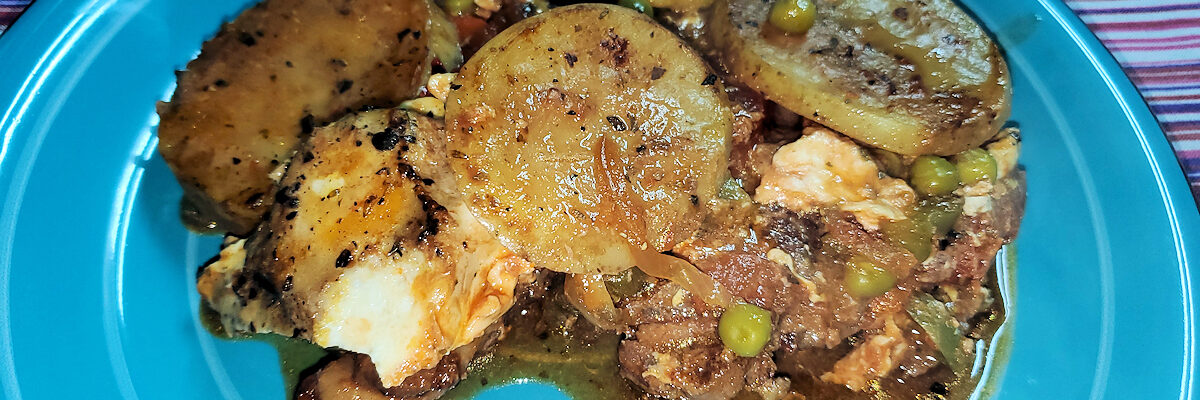
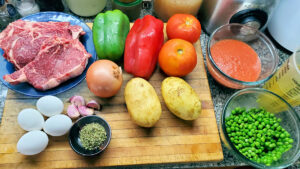
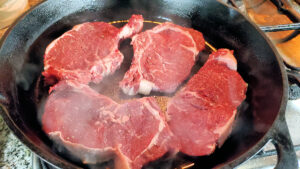
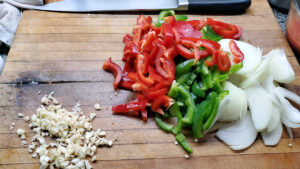
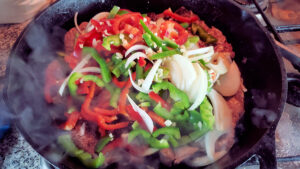

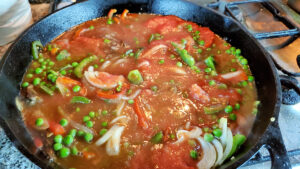
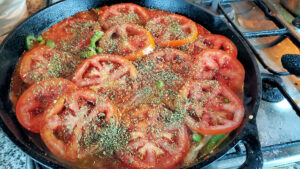
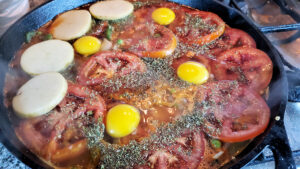
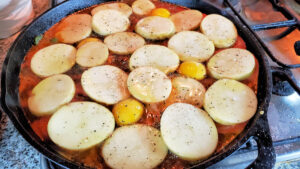
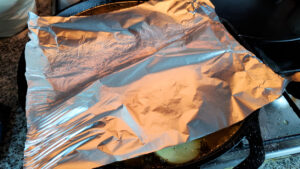
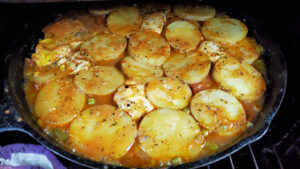
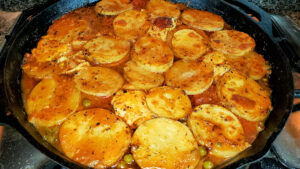
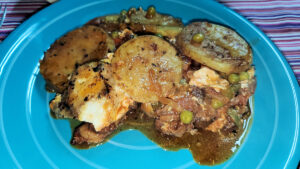
[…] I also kind of fell in love with an Argentine classic braised steak dish, bifes a la criolla. […]
[…] Bifes a la criolla – not what any of us at the table think of as this dish, but that may be either a regional thing, or a chef’s personal interpretation. For us it was missing all the vegetables and sauce that we’re used to seeing and was a bit bland. The way I learned to make it, and generally see it served, here. […]